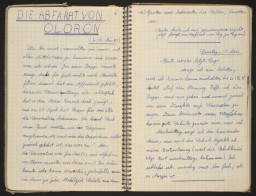You searched for: 数字货币游戏,加密货币游戏,数字币游戏,used博彩游戏,【www.2266.com,复制打开网址】,ust泰达币博彩网站,区块链游戏排名,区块链游戏nft,区块链游戏平台,nft游戏有哪些,nft是什么游戏,以太坊游戏,区块链游戏赚钱网站,币圈游戏,区块链博彩平台,网址kaefhfkccdckbghcd
<< Previous | Displaying results 101-150 of 1782 for "数字货币游戏,加密货币游戏,数字币游戏,used博彩游戏,【www.2266.com,复制打开网址】,ust泰达币博彩网站,区块链游戏排名,区块链游戏nft,区块链游戏平台,nft游戏有哪些,nft是什么游戏,以太坊游戏,区块链游戏赚钱网站,币圈游戏,区块链博彩平台,网址kaefhfkccdckbghcd" | Next >>
-
Opening speech of the US prosecution at the International Military Tribunal
PhotoUS Chief Prosecutor Robert H. Jackson delivers the opening speech of the American prosecution at the International Military Tribunal. Nuremberg, Germany. November 21, 1945.
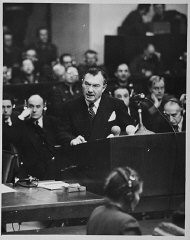
-
Ship used to deport Jews from Norway
PhotoThe Donau, one of the largest ships used to deport Jews from Norway to Germany. From Germany, hundreds of Norwegian Jews were deported to Auschwitz. Norway, 1943.
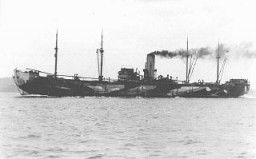
-
Ship used to deport Jews from Norway
PhotoThe Monte Rosa (right), one of the ships used to deport Jews from Norway to Germany. Norway, 1943.
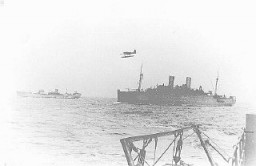
-
House used by members of the Vilna ghetto resistance
PhotoLocated on Ulica Stara (Old Street), outside the Vilna ghetto, this building was used as a safe house by the ghetto resistance. Vilna, after July 1944.
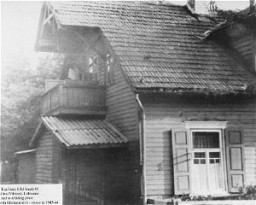
-
Corpses found by US soldiers after the liberation of Gunskirchen
PhotoCorpses found by US soldiers after the liberation of the Gunskirchen camp, a subcamp of the Mauthausen concentration camp. Austria, after May 5, 1945.

-
US troops landing at Normandy on D-Day
PhotoUS troops wade through the surf on their arrival at the Normandy beaches on D-Day. Normandy, France, June 6, 1944.
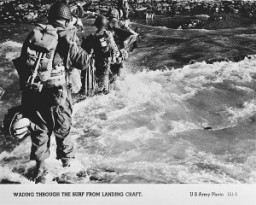
-
US troops pull the survivors ashore on D-Day
PhotoUS troops pull the survivors of a sunken craft on to the shores of the Normandy beaches on D-Day. Normandy, France, June 6, 1944.
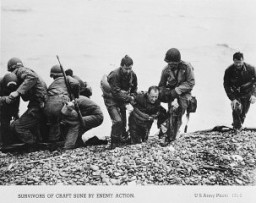
-
US runner Jesse Owens racing the 200 meters
PhotoDuring the 1936 Olympics in Berlin, US runner Jesse Owens begins the 200-meter race in which he established a new Olympic record of 20.7 seconds. Berlin, Germany, August 2, 1936.
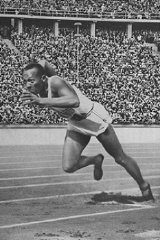
-
US Army soldier views the cemetery at Hadamar
PhotoA US Army soldier views the cemetery at Hadamar, where victims of the Nazi euthanasia program were buried in mass graves. This photograph was taken by an American military photographer soon after the liberation. Germany, April 5, 1945.
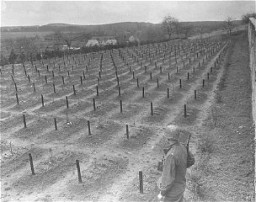
-
Thracian Jews crowded onto a ship used for deportations
PhotoThracian Jews crowded into an interior room of the Karađorđe, used as a deportation ship, just before it left the Danube River port of Lom. From Lom they were loaded onto four Bulgarian ships and taken to Vienna, where they were put on trains bound for the Treblinka killing center in occupied Poland. Lom, Bulgaria, March 1943.
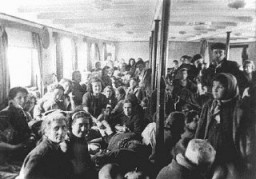
-
US delegation views an underground factory at Dora-Mittelbau
PhotoMembers of a US congressional committee investigating German atrocities view a V-2 rocket on the assembly line of an underground factory at the Dora-Mittelbau concentration camp, near Nordhausen. Germany, May 1, 1945.

-
A US PT boat off the coast of New Guinea
PhotoA US PT (Patrol Torpedo) boat off the coast of New Guinea, during an American counteroffensive against Japanese advances in the Solomon Islands in the eastern Pacific Ocean, 1943.
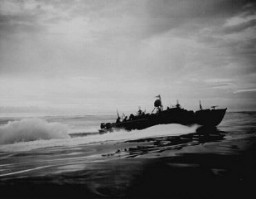
-
False identification card used by Vladka Meed
PhotoFalse identification card which Vladka Meed had used from 1940–42 on the Aryan side of Warsaw, smuggling arms to Jewish fighters and helping Jews escape from the ghetto.
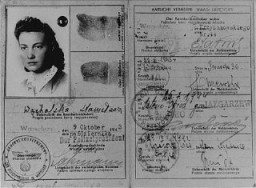
-
US troops wade ashore at Normandy on D-Day
PhotoUS troops wade ashore at Normandy on D-Day, the beginning of the Allied invasion of France to establish a second front against German forces in Europe. Normandy, France, June 6, 1944.
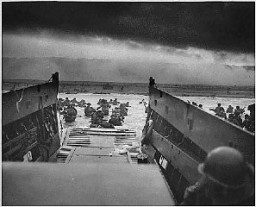
-
Building used to store belongings taken from Jews
PhotoPostwar photograph of a building in Dabie where the possessions of Jews killed at the nearby Chelmno killing center were stored. Dabie, Poland, June 1945.
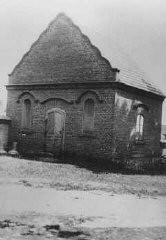
-
Members of the US press view rows of corpses
PhotoVisiting American newspaper and magazine correspondents view rows of corpses in Dachau. Photograph during an inspection following the liberation of the camp. Dachau, Germany, May 4, 1945.
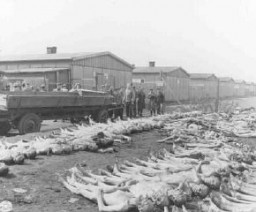
-
Beads used by a Dutch Jewish girl in hiding
ArtifactThese tiny black, white, gold, and clear glass beads were used by Rachel “Chelly” de Groot from November 1942 to April 1944 and recovered by her brother Louis after the war. Chelly used the beads to make handicrafts. On November 16, 1942, Chelly, then 15, Louis, 13, and their parents Meijer and Sophia left Arnhem and went into hiding after the Dutch police warned them of a raid. Meijer and Sophia hid in Amsterdam while Chelly and Louis moved around to different locations. In summer or fall 1943,…
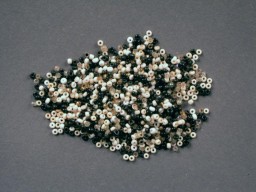
-
Beifeld album page: School used as quarters
Artifact(Bottom) In a drawing dated April 18, 1942, Beifeld shows the school where the Hungarian Labor Service company 109/13 was quartered in Csobanka (Szentendre district), Hungary, before its departure for the Ukraine. A group of Hungarian soldiers [assigned to the labor service company] sits outside in the schoolyard. [Photograph #57947]
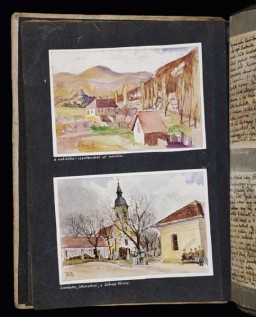
-
Renovating the courtroom to be used for the International Military Tribunal
PhotoRepairs and improvements are made to the courtroom where the International Military Tribunal trial of war criminals would be held. The holes in the walls at the top (when completed) housed radio commentators and public address operators. September 11, 1945.
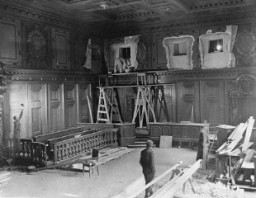
-
US soldiers view the charred remains of prisoners at Ohrdruf
PhotoWhile on an inspection tour of the newly liberated Ohrdruf concentration camp, American soldiers view the charred remains of prisoners burned upon a section of railroad track during the evacuation of the camp. Ohrdruf, Germany, April 4-15, 1945.
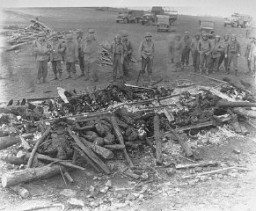
-
Courtyard used for roll call in Breendonk transit camp
PhotoView of the courtyard in the Breendonk fortress prison where prisoners lined up for roll call. Breendonk, Belgium, postwar. This image is taken from a series of snapshots sold on the site after the end of World War II.
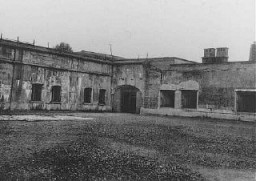
-
Romani (Gypsy) children used in racial studies
FilmEva Justin was an assistant to Dr. Robert Ritter, the Third Reich's "expert" on Roma (Gypsies). She studied these Romani (Gypsy) children as part of her dissertation on the racial characteristics of Roma. The children stayed at St. Josefspflege, a Catholic children's home in Mulfingen, Germany. Justin completed her study shortly after this film was taken. The children were deported to Auschwitz-Birkenau, where most were killed.
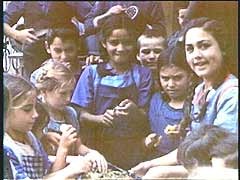
-
Medical Case: US prosecutor details illegal experiments
FilmThe Medical Case was one of 12 war crimes trials held before an American tribunal as part of the Subsequent Nuremberg Proceedings. The trial dealt with doctors and nurses who had participated in the killing of physically and mentally impaired Germans and who had performed medical experiments on people imprisoned in concentration camps. Here, chief prosecutor Brigadier General Telford Taylor reads into evidence a July 1942 report detailing Nazi high-altitude experiments and outlines the prosecution's goals…
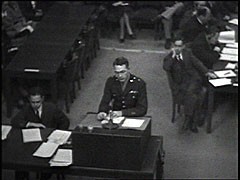
-
US Army Medic POW Diary Entry
Timeline EventApril 2, 1945. On this date, Anthony Acevedo wrote in his diary about his experience as a prisoner of war.
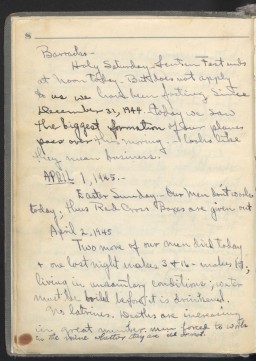
-
Einsatzgruppen trial: US prosecution condemns genocide
FilmAfter the trial of major war criminals before the International Military Tribunal in Nuremberg, the United States held a series of other war crimes trials at Nuremberg—the Subsequent Nuremberg Proceedings. The ninth trial before the American military tribunal in Nuremberg focused on members of the Einsatzgruppen (mobile killing units), who had been assigned to kill Jews and other people behind the eastern front. In this footage of the prosecution's opening statement, US prosecutor Ben Ferencz explains…
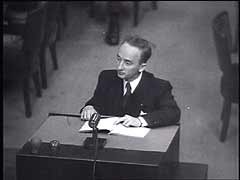
-
US Quakers aid children in defeated France
FilmDuring World War II , the American Friends Service Committee, a Quaker relief organization, provided food, shelter, and other aid to thousands of Jewish refugees—especially Jewish children—in France. The Quakers were active throughout France, even in areas occupied by German forces. In this footage, Quaker relief workers feed children at one of the Quaker-established schools in Marseille in the unoccupied southern zone of France.
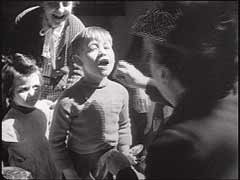
-
Buses used to transport patients from the Eichberg hospital near Wiesbaden to Hadamar
PhotoBuses used to transport patients from the Eichberg hospital near Wiesbaden to Hadamar euthanasia center. The windows were painted to prevent people from seeing those inside. Germany, between May and September 1941.
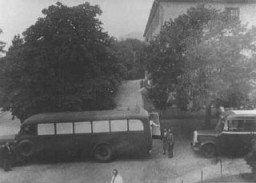
-
A Dutch survivor of Ohrdruf shows the camp's gallows to US forces
PhotoA Dutch survivor of the Ohrdruf camp shows the camp's gallows, which the Germans used to execute prisoners, to US forces (including Generals Eisenhower, Bradley, and Patton). Germany, April 12, 1945.
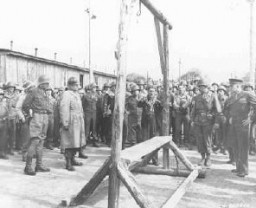
-
US 4th Armored Division soldiers survey the dead at Ohrdruf
PhotoUS soldiers of the 4th Armored Division survey the dead at Ohrdruf, a subcamp of the Buchenwald concentration camp. Germany, April 1945.
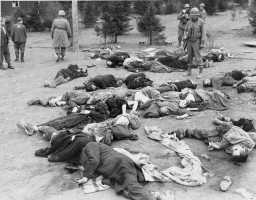
-
Milk can used to store content of the Oneg Shabbat archives
ArtifactOne of the milk cans used by Warsaw ghetto historian Emanuel Ringelblum to store and preserve the secret "Oneg Shabbat" ghetto archives.This milk can, identified as no. 2, was unearthed at 58 Nowolipki Street in Warsaw on December 1, 1950.
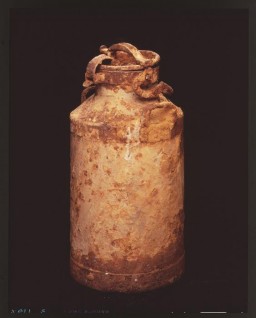
-
Trucks used to transport Polish prisoners to the Palmiry forest for execution
PhotoGerman police and SS personnel wait with a convoy of trucks during a shooting action in the Palmiry forest near Warsaw. These trucks were used to transport prisoners held in the Pawiak and Mokotow prisons. October–December 1939.
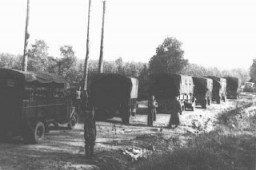
-
US B-17 bomber during a raid over the IG Farben plant
PhotoBombing raid over the I.G. Farben Buna plant. Poland, August 1944.
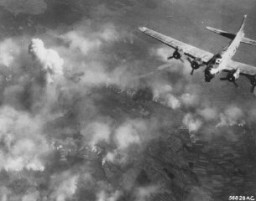
-
Einsatzgruppen trial: Justice Jackson details use of gas vans
FilmAfter the trial of major war criminals before the International Military Tribunal in Nuremberg, the United States held a series of other war crimes trials at Nuremberg during the Subsequent Nuremberg Proceedings.The ninth trial of these proceedings, before an American military tribunal, focused on members of the Einsatzgruppen (mobile killing units) who had been assigned to kill Jews and other people behind the eastern front. This footage shows US Supreme Court Justice Robert Jackson, chief prosecutor for…
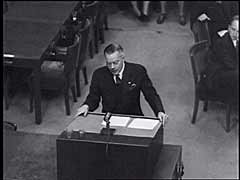
-
US Prosecutor Jackson Delivers Opening Statement to International Military Tribunal
Timeline EventNovember 21, 1945. On this date, Robert H. Jackson delivered opening statements at the International Military Tribunal in Nuremberg.
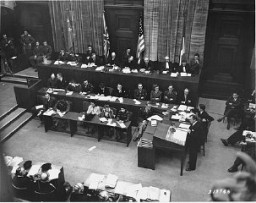
-
Large wooden crate used by Żegota to hide false documents
ArtifactThis large, lidded wooden chest was used by the Council for Aid to Jews (codenamed “Żegota”) to hide false identity documents from Nazi authorities. Żegota was an underground rescue organization of Poles and Jews in German-occupied Poland and operated from December 1942 to January 1945. Supported by the Polish government-in-exile, it coordinated efforts to save Jews in German-occupied Poland from Nazi persecution and murder. One of Żegota’s most impactful clandestine activities was producing and…

-
Romani (Gypsy) musician's violin used in a prewar musical band
ArtifactViolin owned by Rita Prigmore and originally used by her father, who played with his four brothers in a band in Germany before World War II. Rita and her family were members of the Sinti group of Roma (Gypsies). She and her twin sister Rolanda were born in 1943. Rolanda died as a result of medical experiments on twins in the clinic where they were born. Rita and her mother survived the war and moved to the United States, before returning to Germany to run a Sinti human rights organization that sought to…
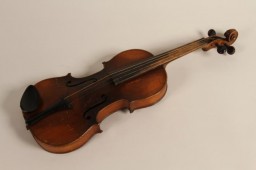
-
Small hooked rug used in the wagon of a Romani (Gypsy) family
ArtifactThis small patterned hooked rug was used as a shoe mat in the wagon of Rita Prigmore and her family when she was a child in Wurzberg, Germany, after World War II. Rita and her family were members of the Sinti group of Roma (Gypsies). She and her twin sister Rolanda were born in 1943. Rolanda died as a result of medical experiments on twins in the clinic where they were born. Rita was returned to her family in 1944. She and her mother survived the war and moved to the United States, before returning to…
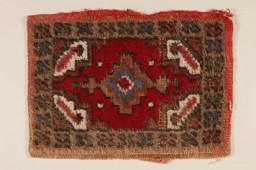
-
Drexel Sprecher describes German documentation that could be used as evidence
Oral HistoryDrexel Sprecher was educated at the University of Wisconsin, the London School of Economics, and at the Harvard School of Law before receiving a position at the US Government's Labor Board in 1938. He enlisted in the American military after the United States declared war on Germany, and was posted to London. After the war, Sprecher served as a prosecutor of Nazi war criminals at the Nuremberg trials.
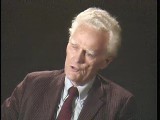
-
Metal box used to hide contents of the Oneg Shabbat archives
ArtifactOne of the ten metal boxes in which portions of the Ringelblum Oneg Shabbat archives were hidden and buried in the Warsaw ghetto. The boxes are currently in the possession of the Jewish Historical Institute in Warsaw.
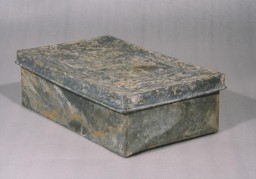
-
Three metal boxes used to hold content of the Oneg Shabbat archive
ArtifactThree of the ten metal boxes in which portions of the Oneg Shabbat archive were hidden and buried in the Warsaw ghetto. The boxes are currently in the possession of the Jewish Historical Institute in Warsaw. In this view the three boxes are stacked on top of one another. The box on top is displayed on its side without the lid.
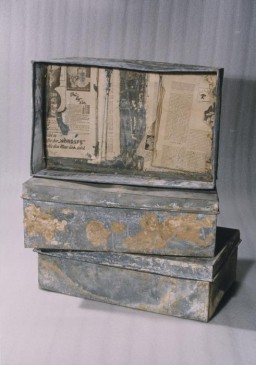
-
Beifeld album page showing houses used as officers quarters
ArtifactIn a drawing dated April 14, 1942, Beifeld shows houses in Csobanka (Szentendre district), Hungary, where the Hungarian military officers assigned to the labor service company were quartered before their departure for the Ukraine. [Photograph #57949]
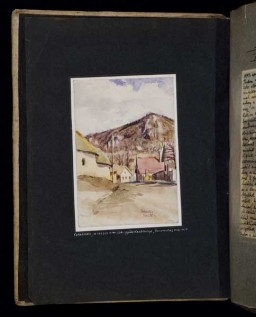
-
Einsatzgruppen trial: US prosecution opens case against Einsatzgruppen members
FilmAfter the trial of major war criminals before the International Military Tribunal in Nuremberg, the United States held a series of other war crimes trials at Nuremberg—the Subsequent Nuremberg Proceedings. The ninth trial before the American military tribunal in Nuremberg focused on members of the Einsatzgruppen (mobile killing units), who had been assigned to kill Jews and other people behind the eastern front. This footage shows US prosecutor Ben Ferencz outlining the purpose of the trial during…
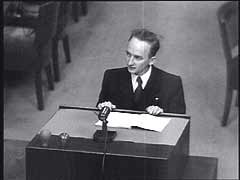
-
US veteran Raymond Buch describes forcing civilians to bury the dead
Oral HistoryAs a US Army sergeant, Raymond fought in the Battle of the Bulge. In May 1945, his unit was deployed to the Mauthausen camp in Austria to bulldoze mass graves for the victims. He watched as German civilians, on US orders, hauled bodies to the mass graves. He also saw stronger camp survivors pull clothes off their weaker counterparts to replace their own tattered uniforms. Raymond went on to Mauthausen's Ebensee camp and Gusen, guarding SS men.
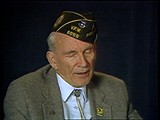
-
David (Dudi) Bergman describes liberation by US Army in mountains near Innsbruck
Oral HistoryThe Germans occupied David's town, previously annexed by Hungary, in 1944. David was deported to Auschwitz and, with his father, transported to Plaszow. David was sent to the Gross-Rosen camp and to Reichenbach. He was then among three of 150 in a cattle car who survived transportation to Dachau. He was liberated after a death march from Innsbruck toward the front line of combat between US and German troops.

-
Robert Mills Donihi describes witnesses at the postwar US trials in Germany
Oral HistoryIn 1945, Robert Mills Donihi was practicing law in Nashville, Tennessee. He accepted a government assignment to Tokyo where he worked on the trial of 28 high-ranking Japanese officers. After a year, he left for Germany, and arrived in Nuremberg in January 1947. Donihi was a member of the legal team at the postwar US trials in Germany, serving as both an interrogator and a prosecutor.
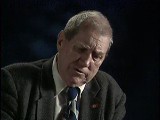
-
US nurse Pat Lynch describes treating survivors in a subcamp of Dachau
Oral HistoryPat was one of thousands of US nurses who served in evacuation hospitals during the liberation of concentration camps in Europe. She cared for camp survivors, many of whom were in critical condition upon liberation.
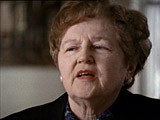
-
US veteran Tarmo Holma describes encountering camp survivors
Oral HistoryTarmo Holma is a veteran of the 11th Armored Division. During the invasion of German-held Austria, in May 1945 the 11th Armored (the "Thunderbolt" division) overran two of the largest Nazi concentration camps in the country: Mauthausen and Gusen.
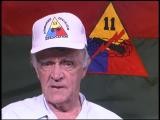
-
Robert Mills Donihi describes defendants at the postwar US trials in Germany
Oral HistoryIn 1945, Robert Mills Donihi was practicing law in Nashville, Tennessee. He accepted a government assignment to Tokyo where he worked on the trial of 28 high-ranking Japanese officers. After a year, he left for Germany, and arrived in Nuremberg in January 1947. Donihi was a member of the legal team at the postwar US trials in Germany, serving as both an interrogator and a prosecutor.
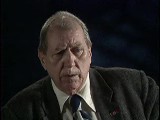
-
Barbara Ledermann Rodbell describes using false papers and living in hiding
Oral HistoryDescribes using false papers and living in hiding
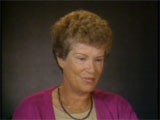
-
Hans Vogel's diary entry about receiving US immigration papers
ArtifactDiaries reveal some of the most intimate, heart-wrenching accounts of the Holocaust. They record in real time the feelings of loss, fear, and, sometimes, hope of those facing extraordinary peril. The diary of Hans Vogel, who fled Paris with his family while his father was interned, contains hand-drawn and colored maps of their flight. This page describes receiving papers allowing the family to immigrate to the United States. Hans was born in Cologne, Germany on December 3, 1926. The family left Germany…
